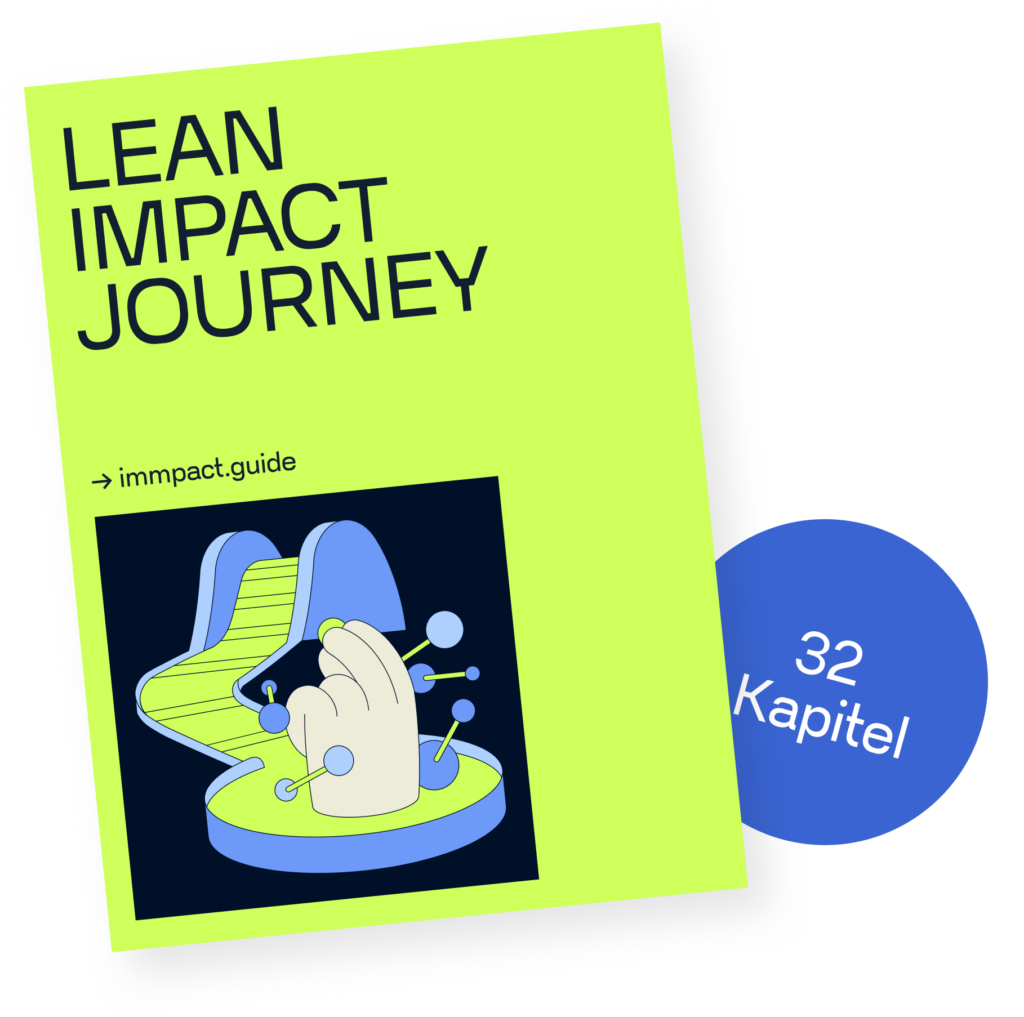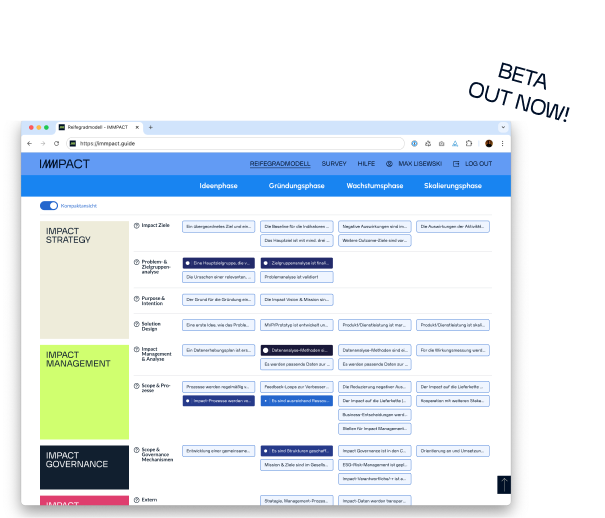Leverage proven lean startup principles to tackle social challenges effectively. Develop impactful solutions through iteration, feedback and agility.
What is Lean Impact?
Lean Impact combines the agility and creativity of the lean startup approach with a focus on driving lasting social change. While lean startups prioritize bringing products to market quickly, Lean Impact emphasizes building solutions that are both impactful and sustainable.
You can download the (German) version of this guide as PDF here.

The three core principles of Lean Impact:
- Build: Develop early prototypes to gather feedback as soon as possible.
- Measure: Collect meaningful data to test assumptions and make informed decisions.
- Learn: Use insights to continuously refine your strategy and maximize your impact.
Why Lean Impact matters for founders:
- Adapt quickly: Avoid long development cycles by gathering early feedback.
- Efficiency: Focus your resources where they create the greatest impact.
- Maximum impact: Iterate and optimize solutions to effectively tackle social challenges.
The four phases of the Lean Impact Journey
The Lean Impact journey unfolds in four key phases, taking you from problem analysis and idea generation to scaling your solution. Each phase is designed to keep your startup agile and impact-driven.

PHASE 1
IDEATION
Defining the problem, target groups and stakeholders
Identify relevant issues. Pinpoint key stakeholders and your target audience’s needs.
Defining the problem, target groups and stakeholders
What social challenge are you addressing? Who are the key stakeholders? What are your target group’s needs?
Collect data
Use interviews, surveys and observations to gain deeper insights.
Validate and adapt
Learn from feedback, adjust your approach and determine what’s feasible with your available resources.
Solution design
Develop and test early-stage solutions to refine your approach.
Solution design
Develop and refine initial ideas to address your social challenge.
Collect data
Assess how your target audience responds to your ideas and identify the most promising solution.
Validate and adapt
Learn from feedback, adjust your approach and determine what’s feasible with your available resources.
PHASE 2
PROTOTYPING
Prototype development and market analysis
Quickly develop and refine prototypes. Learn more about your market.
Prototype development
Create simple models or pilot projects that can be tested quickly and cost-effectively.
Collect data
Gather feedback from your target audience to understand what works – and what doesn’t.
Market analysis
Evaluate the market potential and demand for your solution.
Collect data
Validate your market analysis with real-world data.
Validation
Adjust your approach based on what you’ve learned.
MVP development and financing strategy
Develop your MVP, test it with pilot customers and develop a financing strategy.
MVP development
Build a market-ready product that captures the core of your solution and is prepared for growth. Define early outcome indicators to measure impact.
Test your MVP
Evaluate its acceptance and effectiveness under real-world conditions.
Draw up a financing strategy
Plan your next steps to attract partners and investors.
Test your financing strategy
Engage with financial experts and investors to gather feedback.
Validate and adapt
Use insights from feedback to refine both your MVP and funding strategy.
PHASE 3
GROWTH
Product development and growth planning
Refine your product, build the necessary structures, and develop your team to prepare for sustainable growth.
Strengthen your team, processes and structures
Optimize your team, streamline operations and shape your organizational culture for long-term success.
Plan for financial growth
Make your solution market-ready, expand your customer base and implement targeted growth strategiess.
Manage and measure impact
Refine your impact indicators and identify potential risks or unintended consequences.
Measure KPIs
Assess whether your solution is achieving its intended social impact and financial goals.
Make data-driven decisions
Continuously analyze your progress, identify weaknesses and optimize processes for sustainable growth.
PHASE 4
SCALING
Scaling
Create a plan to expand your impact and ensure it is thoroughly assessed.
Manage, validate and scale your impact
Choose the right scaling strategy, build the necessary infrastructure and develop expertise for robust impact measurement. Validate your impact externally to ensure effectiveness
Measure KPIs
Track whether your solution is achieving its desired social impact and financial goals.
Make data-driven decisions
Continuously analyze your progress, identify challenges, and optimize processes for sustainable growth
Improve quality through agility and self-reflection
Self-reflection is a key component of Lean Impact. Regularly ask yourselves:
- “Are we reaching the people we aim to support?”
- “How can we better use feedback from our target group?”
- “What resources do we need to maximize our impact?”
Use our self-assessment tool to evaluate your project’s maturity and identify concrete ways to improve.

Lean Impact Journey references and sources
Andersen, B., Fagerhaug, T., & Beltz, M. (2010). Root Cause Analysis and Improvement in the Healthcare Sector: A Step-by-Step Guide. ASQ Quality Press.
Badakhshan P, Conboy K, Grisold T, vom Brocke J (2020). Agile business process management: a systematic literature review and an integrated framework. Bus Process Manag J 26:1505–1523.
Barinaga, E. (2012). Overcoming inertia: the social question in social entrepreneurship. In D. Hjorth (Ed.), Handbook on Organizational Entrepreneurship (pp. 242–256). Edward Elgar Publishing Limited.
Bertelsmann Stiftung. (2015). Scaling social impact in Europe. Gütersloh: Bertelsmann Stiftung.
Chang, A. M. (2018). Lean Impact: How to Innovate for Radically Greater Social Good. John Wiley & Sons.
Croll, A., & Yoskovitz, B. (2013). Lean Analytics: Use Data to Build a Better Startup Faster. O’Reilly Media.
Eisenmann, T. (2021). Why startups fail: A new roadmap for entrepreneurial success. Crown Currency.
Harmon,P. (2015). The scope and evolution of business process management. In: vom Brocke J, Rosemann M (eds) Handbook on business process management 1: introduction, methods, and information systems. pp 37–80
Khandker, S.R.; Koolwal, G.B.; Samad, H.A. (2009). Handbook on Impact Evaluation: Quantitative Methods and Practices; World Bank Publications
Maurya, A. (2010). Running Lean: Iterate from Plan A to a Plan That Works. O’Reilly Media.
Olsen D. (2015), “The Lean Product Playbook: How to Innovate with Minimum Viable Products and Rapid Customer Feedback”, Wiley, Hoboken
Osterwalder, A., & Pigneur, Y. (2010). Business Model Generation: A Handbook for Visionaries, Game Changers, and Challengers. John Wiley & Sons.
PHINEO & Bertelsmann Stiftung. (2021). Course book impact. 6th revised edition, February. Berlin: PHINEO gAG.
Pitagorsky, G. (2010). Time-to-Value and the Value of Time. PMtimes.
Ries, E. (2011). The Lean Startup: How Today’s Entrepreneurs Use Continuous Innovation to Create Radically Successful Businesses. Crown Business.
Rogers, E. M. (2003). Diffusion of Innovations (5th ed.). Free Press.
Sammut-Bonnici, T., & Galea, D. (2015). SWOT analysis. Wiley Encyclopedia of management, 12(1).
Serrat, O., & Serrat, O. (2017). The five whys technique. Knowledge solutions: Tools, methods, and approaches to drive organizational performance, 307–310.